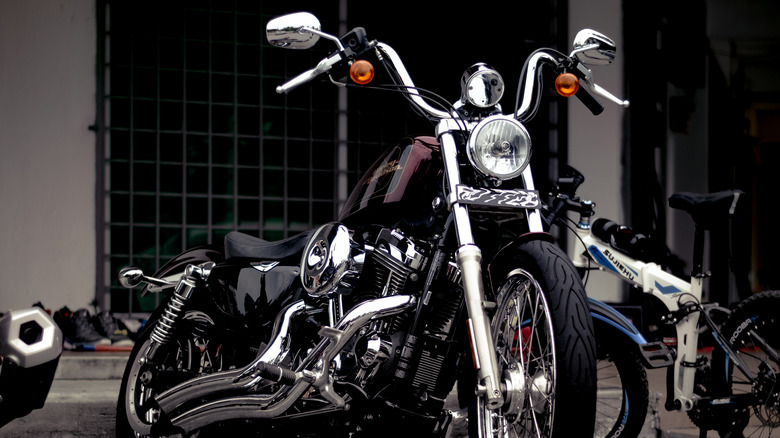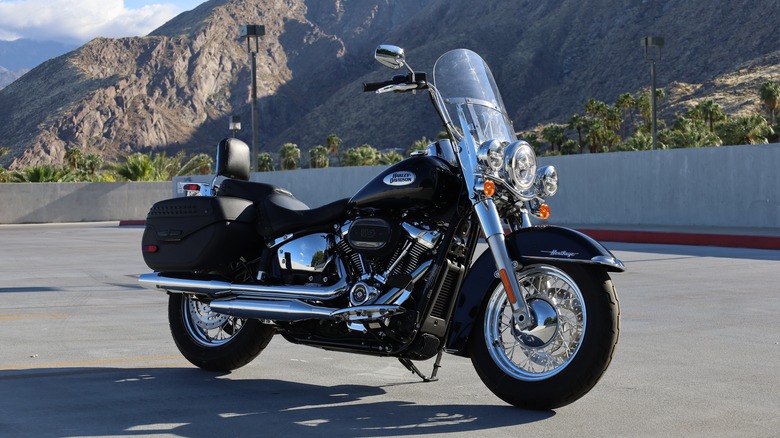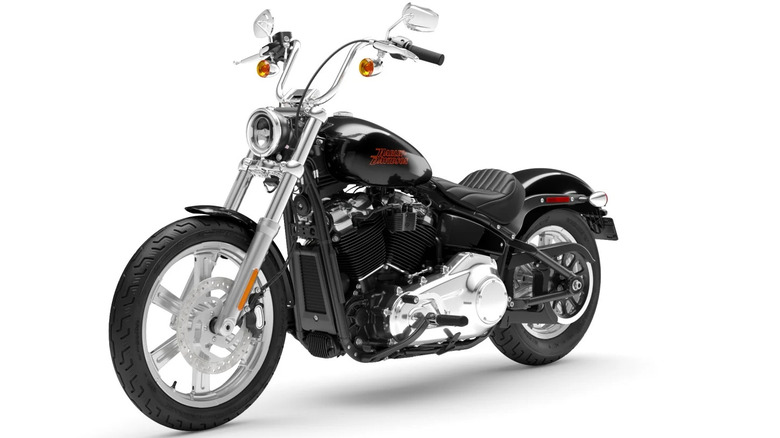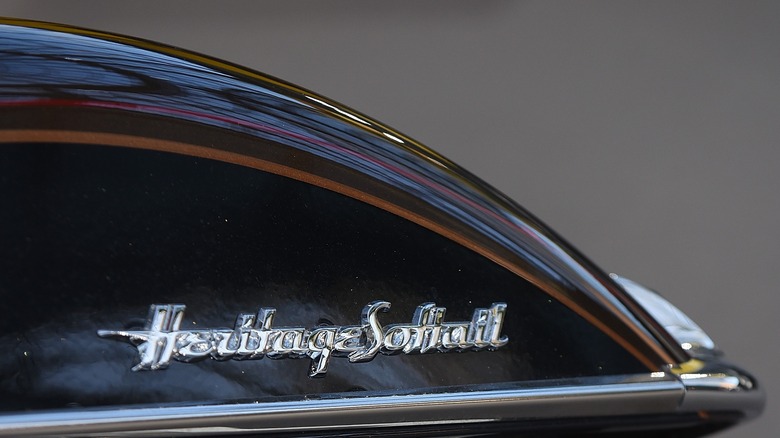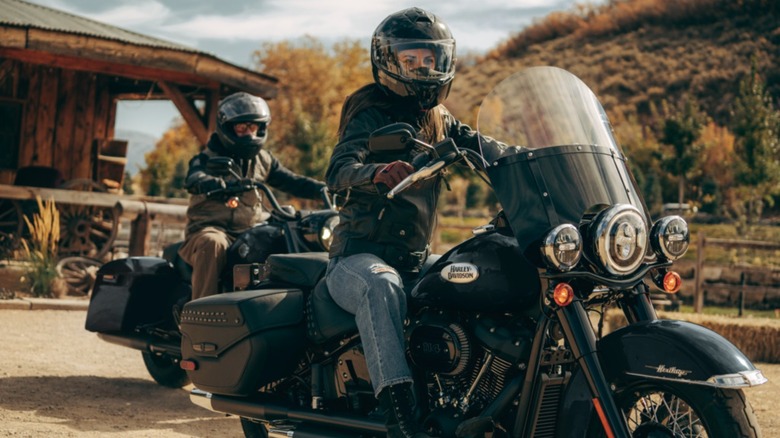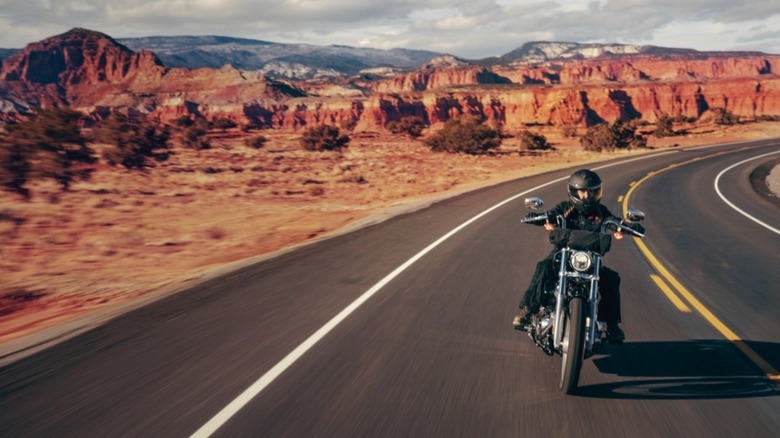Harley-Davidson Heritage Softail Classic Vs. Softail: What's The Difference?
Softail motorcycles distinguish themselves from hardtails with their implementation of rear suspension. Engineer and Harley enthusiast, Bill Davis was the visionary who ultimately kicked off the work on the Softail in 1974, designing and refining a frame, which he dubbed the "Sub Shock," and sold through his own company — Road Worx. In 1982, after years of trying to agree terms with Harley Davidson designers, he sold the design and associated materials to the company. The FXST Softail arrived the very next year.
The Heritage Softail made its debut in 1986, and now, almost forty years later, the Softail is a mainstay of Harley-Davidson in a variety of different guises. It's unsurprising that the style took off, with many riders eschewing the Hardtail's lack of suspension in its favor. As such, Harley Softails include the Fat Boy, Street Bob, and the Softail Standard. Like most Harleys, softails are cruiser-styled, and they're great options for riders who want to stay in the saddle for longer periods in relative comfort.
While cruisers aren't necessarily the most elegant machines to handle and can be heavy (as any rider of the 699-pound 2018 Fat Boy pictured here will know), they're popular rides, and the Heritage Softail Classic and Softail Standard each offer something a bit different to potential customers beyond their aesthetics. Let's compare crucial aspects of both models, including their specs, prices, and the range of customization options available to each.
The specs of the Heritage Classic 114 versus the Softail Standard
We'll start with what is probably the most significant factor in any vehicle-versus-vehicle debate: what can they do when opened up? While Harley-Davidson describes its 2024 Softail Standard as "an ideal blank canvas for customization," it's important to consider the capabilities of the machine as they are before any modifications are made. The 2024 Standard, then, is powered by the Milwaukee-Eight 107 engine, offering 110 lb.-ft. of torque and a maximum power output of 87 horsepower.
By comparison, the same year's Heritage Classic 114 boasts — as the name suggests – a Milwaukee-Eight 114, another entry in the Big Twin line of engines (the Milwaukee-Eight series was introduced in August 2016). It offers 94 horsepower as a result of the larger engine, while its torque is similarly boosted to 119 lb.-ft.
Both models are outdone in these figures by the most formidable entries in Harley's cruiser lineup, including the Breakout 117 with its Milwaukee-Eight 117 that boasts 101 horsepower and 123 lb.-ft. torque. As such, neither the Heritage nor the Standard are the first choice for raw numbers. But numbers aren't everything, and there are other important differences between the two models. Typically, an increase in technical specs will translate to an increase in cost, so let's see how this can factor into our hypothetical decision between the two softails.
The Heritage Softail Classic comes at a premium
The 2024 Softail Standard has an MSRP of $14,999, but the price can go up if you go for the $950 ABS option, and $350 for the Vivid Black paint scheme instead of the standard "billiard gray."
The '24 Heritage Classic 114 comes at a significantly higher price of $22,499, and there are a lot more color and trim options available here. Beyond the base chrome trim and Billiard Gray style, you can instead choose the $1000 black trim, or one of four alternate colors: There's the $350 Vivid Black and the Red Rock/Vivid Black ($850), with two $650 options – Atlas Silver Metallic and Alpine Green, if you fancy paying the extra in order to stand out from the crowd.
These are simply Harley's respective MSRPs for the two '24 models, meaning that prices can vary in the showroom or if you choose a used model.
Additional features of the Heritage Softail Classic
Sometimes, advanced features are available as options, ones that riders can eschew if they know they won't benefit from them. By doing so, it's possible to drive down the ultimate price of the model somewhat. In cases such as that of the Heritage Softail Classic, on the other hand, some of those features are already included and in the cost of the bike.
ABS is only available for the factory Softail Standard '24 at a $950 premium. With the Heritage Classic, it's included as standard, along with cruise control, and a security package.
In practical terms, the Heritage Classic offers roomy saddlebags, and a passenger seat, neither of which is present on the Softail standard. It also has an advantage in fuel capacity at 5 gallons compared to the Standard's 3.5 gallons. With these features in mind, the Heritage Classic serves as a straight-from-the-dealer model that can be loaded up with whatever you want to transport — be it human, supplies, or property — knowing that you also have a range advantage over the Standard that also lends itself to potential longer rides. Such features, meanwhile, do contribute to the overall size of the model.
The dimensions of the models
Your level of experience with motorcycles, your intended frequency, terrain, and length of rides will all play a part in the machine you choose. Personal taste will also be a big factor as well. Though the Softail Standard and Heritage Softail Classic aren't hugely different in terms of specs, a big thing to bear in mind is that the Heritage model is considerably larger, in more ways than one.
The Classic 114 is almost four inches longer than the Standard, at 95.1 inches to the latter's 91.3. At 728 lbs, it's also 73 pounds heavier than its fellow Softail. Motorcycle veterans will know that another important dimension is the height of the seat. The Heritage Classic has a seat height that measures 26.3 inches, versus the Standard's 25.8 inches.
A similar and significant factor that differentiates the cruisers is that the Softail Standard boasts mid-mount controls, while the Heritage utilizes floorboards. Riders may find that boards are a more natural fit for the position they often adopt with cruisers, and that these, too, are more comfortable when you're engaging in long-distance travel. Comfort in these cases, after all, is about more than just the seat. This isn't to say that one or the other is necessarily better.
Is a Softail Classic or Heritage Softail Classic a better option for you?
The Heritage Softail Classic, as we've seen, has an advantage in terms of the raw power it supplies, and although that's certainly enough of a reason for many riders, there's much more to think about than that. The word Heritage, of course, was a very intentional choice on Harley's part, and one that also shaped the aesthetic and design of the Heritage Classic.
In looking at the differences between the Softail Standard and Heritage Softail Classic for this piece, we reviewed the specs of the 2024 editions of each, the included standard features, and the suite of customization options each offers as purchased from Harley. Then, of course, there's one of the most important factors of all: the price.
In September 2023, SlashGear deemed the Softail Standard to be the greatest budget Harley, dubbing it the brand's "entry-level cruiser" and praising the way it was manufactured to be "more accessible to riders of all preferences, with its low seat, easy-reach handlebars, and mid-mounted footpegs." While "modest" may not be the operative word, it neatly summarizes the Standard in relation to the Heritage Classic: A neat, basic, welcoming cruiser that's perfect for city riding, and that will treat newcomers and experienced riders well, while being open to customization. The somewhat beefier Heritage Classic, while still offering these perks, is perhaps a little more intimidating.
